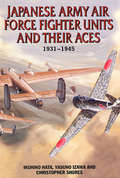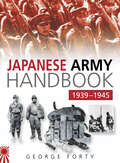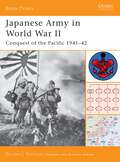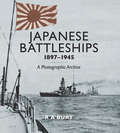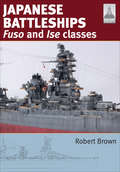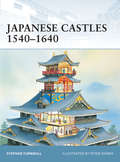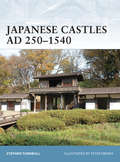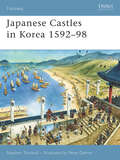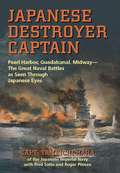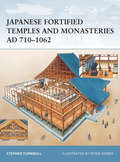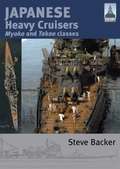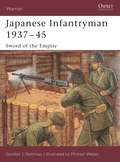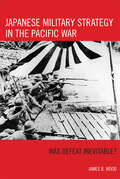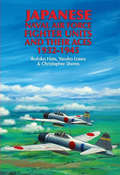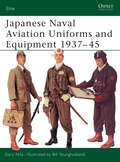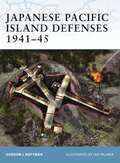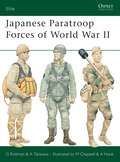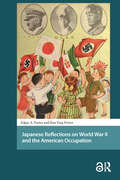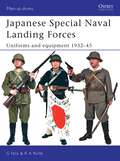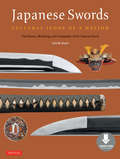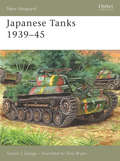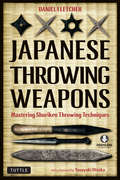- Table View
- List View
Japanese Army Air Force Units and Their Aces, 1931–1945: 1931-1945
by Christopher Shores Yasuho Izawa Ikuhiko HataAn extensive guide to Japan&’s Army Air Force Units and their ace pilots during conflicts in the 1930s and &‘40s, now in English. Commencing with a detailed study of the development, equipment, and operations flown by this force since its inception immediately after the end of World War I, until the catastrophic conclusion of World War II, the initial section deals with the wars in China and Manchuria, as well as the Pacific War of 1941-1945. The second section explores the history of each unit, listing the types of aircraft used, the bases from which they flew, and the unit and formation commanders. Notable mission details are also included. Finally, the third section offers biographical notes for notable fighter pilots and features supporting listings and a glossary of Japanese terms. Photographs of pilots and aircraft are also included, along with line drawings indicating the unit markings carried. This revised edition is a companion volume to Japanese Naval Air Force Fighter Units and Their Aces, 1932–1945.
Japanese Army Handbook 1939-1945: 1939-1945
by George FortyThis is an insight into the most feared army of World War II. The Japanese Imperial Army grew from 1.5 million men in 1939 to 5.5 million men by the end of the war. Their highly successful campaigns in the Far East and the Pacific at the beginning of World War II were every bit as spectacular as those of the Germans in Europe, and they earned an enviable reputation as expert jungle fighters which it took some years for the Allies to match. Their code of honour also made them extremely cruel enemies to prisoners and civilians alike, while their Kamikaze suicidal tendencies meant they would automatically fight to the last without any thought of surrender. Fully illustrated with rare archive photographs, this is a comprehensive study of the army. The author describes how they mobilized and trained their soldiers, and looks at their organizational structures, from high command down to divisional level and below. Also included are uniforms, equipment, all kinds of weapons ranging from tanks and artillery, technical equipment, tactics, symbology and vehicle markings.
Japanese Army in World War II
by Gordon RottmanThe Japanese conquest of the Pacific comprised of a complex series of widely scattered operations; their intent was to neutralize American, Commonwealth, and Dutch forces, seize regions rich in economic resources, and secure an outer defense line for their empire. Although their conquest was successful, the forces deployed from Japan and China were not always ideally trained, equipped and armed. The South Seas and tropics proved challenging to these soldiers who were used to milder climates, and they were a less lethal enemy on the Chinese mainland. This book examines the overall structure of the Imperial Japanese Army (IJA), the forces in existence at the beginning of World War II and the organization of the forces committed to the conquest of the Pacific.
Japanese Battleships, 1897-1945: A Photographic Archive
by R.A. BurtRare images of the Imperial Japanese Navy&’s fleet before it was almost completely destroyed in World War II. This photographic archive contains some 125 stunning images of the battleships of the Imperial Japanese Navy, many unfamiliar, some very rare. They constitute an archive that is pretty much without equal in publications in the West. The period covered is from the launch of Japan's first real contemporary battleship, Yashima, built by Armstrong&’s on the Tyne, up to the final destruction of her fleet in the Pacific in 1945. During that time Japan built up the third largest navy in the world and, before the First World War, it was Britain that armed her at sea. All her dreadnoughts saw action in the Second World War, and of all these numerous ships only Nagato survived the conflict. She was to become a target in the Bikini A-bomb tests in 1946. Just as the ships were lost, so were the majority of photographic records, and relatively few images have come down to us. This selection from R.A. Burt's archive represents therefore a remarkable portrayal of these ships. Extended captions and ship specifications enhance its reference value, making it an essential volume for enthusiasts, modelers, and anyone with an interest in the Second World War.
Japanese Battleships: Fuso & Ise Classes (ShipCraft #24)
by Robert BrownThis fully illustrated guide offers historical context and step-by-step instruction for building and modifying Japanese battleship models. This volume in the ShipCraft series covers the two related classes of Japanese 14in-gunned battleships, originally built during the First World War but subsequently reconstructed. These ships are famous for their towering forward superstructure, usually described as a pagoda bridge, that they featured when rebuilt. The Ise-class ships underwent further reconstruction during the Second World War to emerge as a unique hybrid of battleship and aircraft carrier to compensate for fleet carriers sunk earlier in the war. This lavishly illustrated guide takes readers through a brief history of the Fuso-class and Ise-class ships, highlighting differences between sisterships and changes in their appearance over their careers. It features color profiles of paint schemes as well as detailed line drawings and scale plans. The modelling section reviews the strengths and weaknesses of available kits, lists commercial accessory sets for super-detailing, and provides hints on modifying and improving the basic kit. This volume also includes a photographic survey of selected high-quality models in a variety of scales and a section on further research references
Japanese Castles 1540-1640
by Peter Dennis Stephen TurnbullThe landscape of 16th- and 17th-century Japan was dominated by the graceful and imposing castles constructed by the powerful 'daimyo' of the period. In this the most turbulent era in Japanese history, these militarily sophisticated structures provided strongholds for the consolidation and control of territory, and inevitably they became the focus for many of the great sieges of Japanese history: Nagashino (1575), Kitanosho (1583), Odawara (1590), Fushimi (1600), Osaka (1615) and Hara (1638), the last of the battles that brought an end to a period of intense civil war. This title traces their development from the earliest timber stockades to the immense structures that dominated the great centres of Osaka and Edo.From the Trade Paperback edition.
Japanese Castles AD 250-1540
by Stephen TurnbullDr Stephen Turnbull is internationally recognised for his research into and writing on Japanese military history. Here he applies his scholarship to an account of the evolution of Japanese defensive architecture and engineering, from early earthworks through to wooden and earth castles and, finally, the emergence of the stone towers that are so characteristic of the samurai. He also plots the adaptation of Japanese castles to accommodate the introduction of firearms. With unpublished photographs from the author's private collection and full-colour artwork, including detailed cutaways, this is an essential guide to the fascinating development of Japanese castles.
Japanese Castles in Korea 1592-98
by Stephan TurnbullThe Japanese invasion and occupation of Korea, which lasted from 1592 to 1598, was the only occasion in Japanese history when samurai aggression was turned against a foreign country. During the occupation of Korea the Japanese built 25 wajo or castles. Unlike the castles built in Japan, these castles were never developed or modernized after the Japanese departure meaning that the details of late 16th century castle construction are better preserved than at many other sites. Written by Stephen Turnbull, an expert on the subject, this book examines the castles built by the Japanese in Korea, as well as the use the samurai made of existing Korean fortifications, particularly city walls. This resulted in curious hybrid fortifications which dominated the landscape until the Japanese were pushed out of the peninsula by a furious onslaught from the huge Chinese armies.
Japanese Destroyer Captain
by Roger Pineau Fred Saito Tameichi HaraThis highly regarded war memoir was a best seller in both Japan and the United States during the 1960s and has long been treasured by historians for its insights into the Japanese side of the surface war in the Pacific. The author was a survivor of more than one hundred sorties against the Allies and was known throughout Japan as the Unsinkable Captain. A hero to his countrymen, Capt. Hara exemplified the best in Japanese surface commanders: highly skilled, hard driving, and aggressive. Moreover, he maintained a code of honor worthy of his samurai grandfather, and, as readers of this book have come to appreciate, he was as free with praise for American courage and resourcefulness as he was critical of himself and his senior commanders.
Japanese Eyes American Heart: Personal Reflections of Hawaii's World War II Nisei Soldiers
by Hawaii Nikkei History Editorial Board Tendai Education Foundation StaffJapan's attack on Pearl Harbor on December 7, 1941, set Hawaii on a new course of history that would affect every living soul in these Islands. How Hawaii's people, particularly those of Japanese ancestry, responded to the act of aggression by Japan changed Hawaii's social, economic, and political history forever. Much has been written about how Americans of Japanese ancestry (AJA) in the 100th Infantry Battalion, 442nd Regimental Combat Team, Military Intelligence Service, and the 1399th Engineer Construction Battalion answered their country's call through military service--and the high price they paid in human lives in freedom's cause. The history has been recorded, the battles documented, the medals tallied, the social and political legacy articulated and applauded. Not as thoroughly recorded, however, are the thoughts and innermost feelings of the nisei soldiers who put their lives on the line for their country, and what those experiences meant to them. Those stories have always been the most difficult to pry from the hearts and souls of the AJA men who served our country in World War II. It was that void in the story of Hawaii's nisei soldiers that Bishop Ryokan Ara of the Tendai Educational Foundation asked members of the Hawaii Nikkei History Editorial Board to fill. Japanese Eyes... American Heart is the result of that effort. It is a rare and powerful collection of personal thoughts written by the soldiers themselves, reflections of the men's thoughts as recorded in diaries and letters sent home to family members and friends, and other expressions about an episode that marked a turning point in the lives of many.
Japanese Fortified Temples and Monasteries AD 710-1062
by Stephen TurnbullFrom the 10th century onwards the great Japanese monastic foundations of Nara and Mount Hiei maintained large armies of warlike monks. The tempestuous political rivalries that developed between the different orders of monks and religiously inspired laymen ensured that their temples and monasteries had to be securely sited and robustly defended. This books recreates these enormous fortified monasteries and temples, tracing their development from the 10th century through to the Sengoku Jidai period and the rise of the power of the shogunate under Tokugawa Ieyasu.
Japanese Heavy Cruisers: Myoko and Takao Classes (ShipCraft #Vol. 5)
by Steve BackerThe ShipCraft series provides in-depth information about building and modifying model kits of famous warship types. Lavishly illustrated, each book takes the modeller through a brief history of the subject class, highlighting differences between sister-ships and changes in their appearance over their careers. This includes paint schemes and camouflage, featuring colour profiles and highly-detailed line drawings and scale plans. The modelling section reviews the strengths and weaknesses of available kits, lists commercial accessory sets for super-detailing of the ships, and provides hints on modifying and improving the basic kit. This is followed by an extensive photographic gallery of selected high-quality models in a variety of scales, and the book concludes with a section on research references books, monographs, large-scale plans and relevant websites.rnrnThis volume is devoted to the largest cruisers in the Imperial Japanese Navy. Built in defiance of treaty restrictions, they were the fastest and most powerful heavy cruisers of their day, and were heavily engaged in every campaign from Pearl Harbor to the end of the Pacific War.
Japanese Infantryman 1937-45
by Gordon Rottman Michael WelplyThis book examines in detail the Japanese Infantryman who was, despite comparisons with the notorious German Waffen SS of World War II (1939-1945), an enigma to Westerners. Brutal in its treatment of prisoners as well as the inhabitants of the areas that it conquered, the Imperial Japanese Army also had exacting standards for its own men - strict codes of honor compelled Japanese soldiers to fight to the death against the more technologically advanced Allies. Identifying the ways in which the Japanese soldier differed from his Western counterpart, the author explores concepts such as Bushido, Seppuku, Shiki and Hakko Ichi-u in order to understand what motivated Japanese warriors.
Japanese Inn: A Reconstruction Of The Past
by Oliver StatlerThe beguiling story of the Minaguchi-ya, an ancient inn on the Tokaido Road, founded on the eve of the establishment of the Tokugawa shogunate. Travellers and guests flow into and past the inn -- warriors on the march, lovers fleeing to a new life, pilgrims on their merry expeditions, great men going to and from the capital. The story of the Minaguchi-ya is a social history of Japan through 400 years, a ringside seat to some of the most stirring events of a stirring period.'Statler has created a strangely beautiful book that succeeds in conveying intact not only a great deal of its history but the mood of that land. The result is sheer delight. Japanese Inn is the work of a master craftsman; it is so well conceived that the narrative moves from past to present in the same paragraph without the slightest confusion to the reader; it is so well written that only in retrospect is one aware of its remarkable flawless style. Through the author's particular magic, the stories unfold as one narrative, as beautifully and memorably as the unrolling of a long Japanese scroll.'--CURT GENTRY'The reader learns much of Japan's past -- and, as is inevitable in a study of that country, of present-day Japanese as well. Mr Statler's prose succeeds in evoking the pageantry of the past in the brilliant color of the kabuki stage. Nothing seems to have been overlooked by the author. Mr Statler's book is Japanese history made easy, and grand entertainment.'-- NEW YORK TIMES BOOK REVIEW'Much of it is told in fictional form. Some of the episodes have come out of family annals and memories, some from the records of the temple; some are imagined; but all could have happened ... Mr Statler has told the story vividly and with sympathy. It moves. It has the authentic feel of Japan.'--INTERNATIONAL HERALD TRIBUNE
Japanese Military Strategy in the Pacific War: Was Defeat Inevitable?
by James B WoodIn this provocative history, James B. Wood challenges the received wisdom that Japan's defeat in the Pacific was historically inevitable. He argues instead that it was only when the Japanese military prematurely abandoned its original sound strategic plan—to secure the resources Japan needed and establish a viable defensible perimeter for the Empire—that the Allies were able to regain the initiative and lock Japanese forces into a war of attrition they were not prepared to fight. The book persuasively shows how the Japanese army and navy had both the opportunity and the capability to have fought a different and more successful war in the Pacific that could have influenced the course and outcome of World War II. It is therefore a study both of Japanese defeat and of what was needed to achieve a potential Japanese victory, or at the very least, to avoid total ruin. Wood's argument does not depend on signal individual historical events or dramatic accidents. Instead it examines how familiar events could have b
Japanese Naval Air Force Fighter Units and Their Aces, 1932–1945
by Christopher Shores Yasuho Izawa Ikuhiko HataAn extensive guide to Japan&’s Naval Air Force Fighter Units and their ace pilots during conflicts in the 1930s and &‘40s, now in English. The book begins by looking at the land- and aircraft carrier-based navy fighter units and their operations from 1932 to 1945, as well as their history and achievements. This is followed with biographical details for all pilots who claimed eight or more aerial victories. The thorough appendix provides detailed listings of all pilots known to have claimed five or more victories (and thus considered to be &“aces&”), listings of the graduation from training of all Japanese Navy fighter pilots, and of fighter pilot casualties. Photographs, maps, and artist&’s side-view drawings and paintings of aircraft relevant to each of the units are also included. This revised edition is a companion volume to Japanese Army Air Force Fighter Units and Their Aces, 1931–1945.
Japanese Naval Aviation Uniforms and Equipment 1937#45
by Gary Nila Bill YounghusbandThis long awaited title provides a fantastic reference resource on the uniforms, dress, flight gear and personal weaponry of the Imperial Japanese Navy airmen of World War II (1939-1945). It includes detailed descriptions of flight gear, including manufacture information, and interviews with IJN pilots such as Sakai, Komachi, Tanimizu, Kawato and Saito regarding the use of a variety of equipment are integrated into the text. Packed with great contemporary illustrations, photographs of original items, and colour pictures, this title provides a meticulously detailed examination of the dress and equipment of the Imperial Japanese Navy's aviators in World War II.
Japanese Pacific Island Defenses 1941-45
by Gordon Rottman Ian PalmerThe prolonged and bloody fighting for control of the Japanese occupied Pacific islands in World War II is a key point in 20th-century warfare. No two islands were alike in the systems and nature of their defensive emplacements, and local improvization and command preferences affected both materials used and defensive models. This title details the establishment, construction and effectiveness of Japanese temporary and semi-permanent crew-served weapons positions and individual and small-unit fighting positions. Integrated obstacles and minefields, camouflage and the changing defensive principles are also covered.
Japanese Paratroop Forces of World War II
by Gordon Rottman Mike ChappellOsprey's examination of Japan's parachute units of World War II (1939-1945). For the first time in English, this book offers a concise but fact-packed account of the organization, equipment, and all operations of Japan's small but elite wartime parachute forces. Correcting and amplifying previous accounts based on wartime intelligence, it traces the Imperial Army's Raiding Regiments and the Imperial Navy's parachute-trained Yokosuka 1st & 3rd Special Naval Landing Forces from the first trials units, through their successful assaults in early 1942, to the last desperate battles and raids of 1944-45. The text is illustrated with rare photographs, and meticulously reconstructed color artwork of the men and their gear.
Japanese Reflections on World War II and the American Occupation (Asian History)
by Edgar Porter Ran Ying PorterThis book presents an unforgettable up-close account of the effects of World War II and the subsequent American occupation on Oita prefecture, through firsthand accounts from more than forty Japanese men and women who lived there. The interviewees include students, housewives, nurses, midwives, teachers, journalists, soldiers, sailors, Kamikaze pilots, and munitions factory workers. Their stories range from early, spirited support for the war through the devastating losses of friends and family members to air raids and into periods of hunger and fear of the American occupiers. The personal accounts are buttressed by archival materials; the result is an unprecedented picture of the war as experienced in a single region of Japan.
Japanese Special Naval Landing Forces
by Christa Hook Gary NilaThe spearhead of Japan's assault landing operations both in China pre-Pearl Harbor, and in US and British territory post-Pearl Harbor, was provided by the Special Naval Landing Forces - 12 numbered battalion-size Imperial Japanese Navy units. They garrisoned a number of the islands which the US Marines then had to re-claim in some of the bloodiest battles of the Pacific War of World War II (1939-1945). These included the infamous battles of Iwo Jima and Okinawa. This book provides a comprehensive treatment of the elite force which has never before been examined in such detail in English, covering weapons and equipment as well as uniform and insignia.From the Trade Paperback edition.
Japanese Swords
by Colin M. Roach Nicklaus Suino"Tracks the fundamental transition from the sword as a mythological instrument to a functional tool for war, and finally to the display art commodity it is today." - Publishers WeeklyAuthor Colin M. Roach collaborated with top-level artisans, historians, and martial arts experts to create a unique, in-depth study of these magnificent weapons from a historical, iconographical, and technological perspective. In addition to a foreword by seventh degree iaido black belt Nicklaus Suino and a sidebar by Mukansa-level polisher Abe Kazunori, Japanese Swords includes rare looks into the world of Mukansa-level swordsmiths Kawachi Kunihira and Gassan Sadatoshi. Complemented by hundreds of stunning high-resolution photos and downloadable material, Japanese Swords is a must-have addition to any Japanophile's library.
Japanese Tanks 1939-45
by Steven Zaloga Peter BullContrary to popular belief, the Japanese Army widely employed tanks within the Pacific theater of war. This title details their key role in the conquests of Singapore and Malaya, as well as their later use in Burma, Saipan, and the Philippines, including in the amphibious assault of Corregidor. Tank development succeeded against the odds, with the programme often neglected to pursue the higher priority of warship development. Their use in the most difficult of terrain is a testament to their ingenuity.Steven J Zaloga's book offers a rare insight into a largely overlooked subject and is rich with photographs and artwork, providing a wonderful resource for the construction and design of these fascinating tanks.From the Trade Paperback edition.
Japanese Throwing Weapons
by Daniel Fletcher Yasuyuki OtsukaJapanese Throwing Weapons is a detailed instruction manual for learning authentic shuriken throwing techniques as practiced in Japan. Daniel Fletcher studied under Japan's most notable shuriken sensei, Yasuyuki Otsuka, of the Meifu Shinkage Ryu and in this book he reveals the secrets learned in his years of study and training.Fletcher explains the origins and purpose of the shuriken as a weapon and provides information on the various types of shuriken used by the historic samurai and ninjas. Fletcher's expert instructions and the enclosed DVD can help anyone become proficient in throwing these weapons.
Japanese Throwing Weapons
by Daniel Fletcher Yasuyuki OtsukaJapanese Throwing Weapons is a detailed instruction manual for learning authentic shuriken throwing techniques as practiced in Japan. Daniel Fletcher studied under Japan's most notable shuriken sensei, Yasuyuki Otsuka, of the Meifu Shinkage Ryu and in this book he reveals the secrets learned in his years of study and training.Fletcher explains the origins and purpose of the shuriken as a weapon and provides information on the various types of shuriken used by the historic samurai and ninjas. Fletcher's expert instructions and the enclosed DVD can help anyone become proficient in throwing these weapons.
